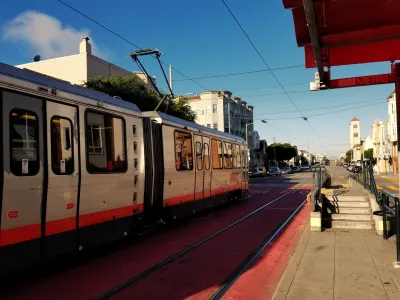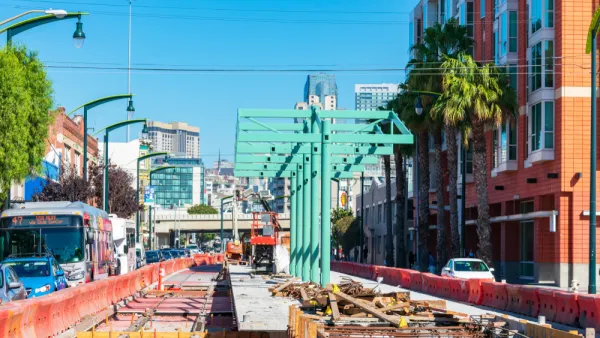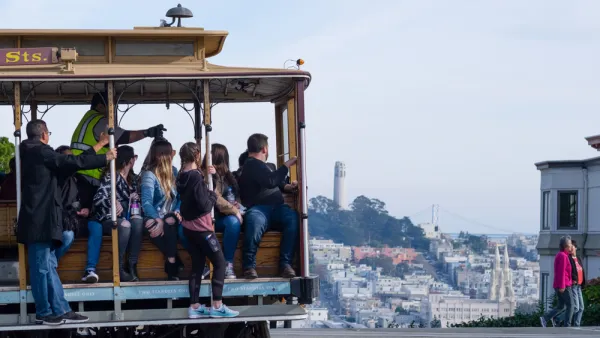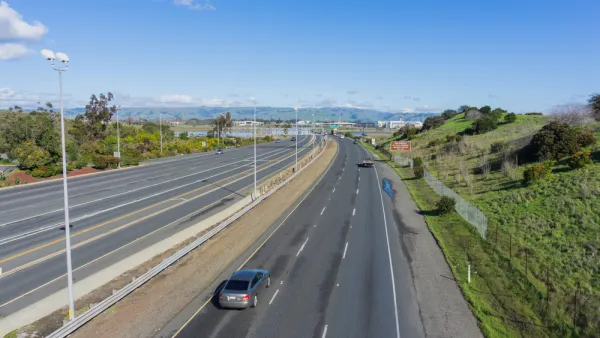The light rail line was supposed to improve transit to less accessible parts of the city, but service so far has been disappointing.

Rachel Swan reports on the T-Third Street Muni light rail line in San Francisco. The line runs through communities along the eastern side of the city, many of which are growing quickly. It was pitched as an alternative to local bus service and a quick and efficient way to move people from some of the city’s more far-flung neighborhoods.
But soon after the line opened in 2007, it was plagued with delays that have continued:
The T line’s problems appear to stem from its design. It hits about 60 intersections looping from Sunnydale to the Folsom portal, where it travels underground to Embarcadero Station and then changes signs to become the K-Ingleside. Most of those intersections have traffic signals that don’t always sync up to give trains priority over other vehicles.
In addition, says Swan, trains are slowed down by cars making illegal left-hand turns and on parts of route where trains share roads crowded with vehicle traffic.
Plans to improve service include using software to help trains get through lights and intersections more easily, addressing problem points on the route, and increasing train capacity by adding additional cars.
With the rapid growth in development in neighborhoods along the route and the demand in ridership that will result, whether these changes will fix the T line’s problems remains to be seen. In addition, residents say 23rd Street in the Dogpatch neighborhood marks the end of gentrification in the area, and they wonder if service improvements will benefit lower-income and more isolated communities to the south.
“Even so, politicians and transit officials still champion the T as a great social equalizer, saying it could pump business into the city’s most neglected neighborhoods and give those residents a quick link to the downtown core,” says Swan.
FULL STORY: The T line has never lived up to its promise. Coming upgrades may not be enough to help

Analysis: Cybertruck Fatality Rate Far Exceeds That of Ford Pinto
The Tesla Cybertruck was recalled seven times last year.

National Parks Layoffs Will Cause Communities to Lose Billions
Thousands of essential park workers were laid off this week, just before the busy spring break season.

Retro-silient?: America’s First “Eco-burb,” The Woodlands Turns 50
A master-planned community north of Houston offers lessons on green infrastructure and resilient design, but falls short of its founder’s lofty affordability and walkability goals.

Test News Post 1
This is a summary

Analysis: Cybertruck Fatality Rate Far Exceeds That of Ford Pinto
The Tesla Cybertruck was recalled seven times last year.

Test News Headline 46
Test for the image on the front page.
Urban Design for Planners 1: Software Tools
This six-course series explores essential urban design concepts using open source software and equips planners with the tools they need to participate fully in the urban design process.
Planning for Universal Design
Learn the tools for implementing Universal Design in planning regulations.
EMC Planning Group, Inc.
Planetizen
Planetizen
Mpact (formerly Rail~Volution)
Great Falls Development Authority, Inc.
HUDs Office of Policy Development and Research
NYU Wagner Graduate School of Public Service




























